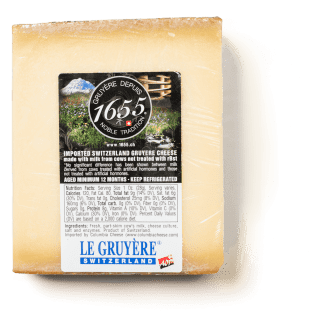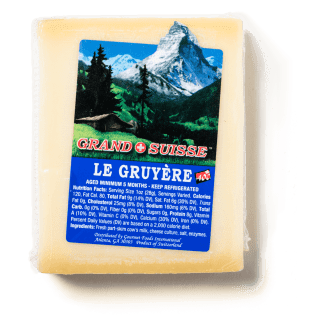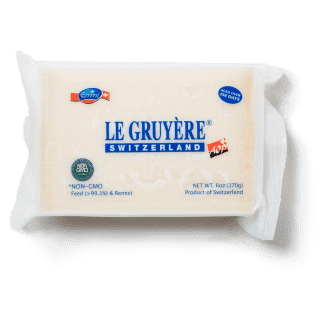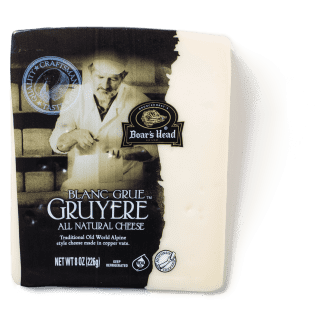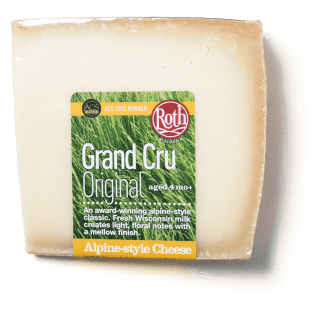What most Americans think of as “Swiss cheese” is the mild, holey stuff called Emmentaler. That cheese is fine for slicing thin and piling on ham sandwiches, but it bears little resemblance to its fellow citizen, Gruyère. The latter, which has been made in the eponymous alpine region of Switzerland for more than 900 years, is pleasantly firm and dense, slightly crumbly, and boasts that faint crystalline crunch that high-quality aged cheeses such as cheddar and Parmesan are known for. Good versions taste deeply nutty and have sweet, fruity tang; nice salinity; and a good bit of earthy funk. Gruyère is also one of a very few cheeses, Swiss or otherwise, that functions just as well in cooked applications as it does on a cheese plate. Scan the test kitchen’s recipe archive and you’ll find roughly 100 recipes featuring it—from breads, soufflés, frittatas, and gratins to scrambled eggs, mashed potatoes, fondue, and French onion soup.
As Gruyère’s stateside popularity has grown over the years, so, too, has its availability in American supermarkets. When we shopped recently, we found eight nationally available options. Five were Swiss imports bearing the Appellation d’Origine Protégée (AOP) seal, meaning they were made according to strict government-mandated rules and quality standards. The other three were domestic facsimiles; two of those, both made by Emmi Roth, stopped calling themselves “Gruyère” several years ago in deference to the Swiss-made cheeses. To find a favorite, we sampled each plain at room temperature, baked in spinach-and-cheese squares, and melted on crostini.
Our Triumvirate of Aged Cooking Cheeses
Parmesan, cheddar, and Gruyère are the three aged cheeses we cook with most often in the test kitchen. Because they range dramatically in flavor and texture, we use them in different ways.
1. GRUYÈRE
Dense, firm, rich, tangy Gruyère is a sophisticated table cheese and a great melter, thanks to its moderate acidity, moisture, and salt.
2. CHEDDAR
Buttery aged cheddar adds gooey richness to griddled sandwiches and casseroles—but because it’s acidic, it will “break” into a greasy mess unless combined with a good melting cheese such as Monterey Jack or American.
3. PARMESAN
Its dry texture and intensely salty-tangy flavor make Parmesan best for seasoning breadings, stirring into risotto and polenta, and sprinkling over pasta.
The Swiss Way
Swiss cheesemakers claim that every part of the rigorous AOP-regulated process contributes to Gruyère’s unique, deeply complex flavor and dense, crystalline texture, starting with the milk itself. It must be raw and from mostly grass-fed cows, since both the Alpine grasses and the bacteria naturally present in unpasteurized milk infuse the cheese with flavor. From there, the milk is mixed with cultures and rennet, which introduce more flavorful bacteria and cause the milk to coagulate into curds, respectively. Then it’s heated in giant copper vats. That particular vessel is important not just because copper heats evenly and responds quickly to changes in temperature but also because copper ions from the surface of the vat leach into the milk and curds and react with compounds in the milk to form desirable and distinct flavor compounds.
High Alpine Standards
Creating Gruyère’s distinctively nutty, tangy, rich flavor starts with the milk itself. According to strict Swiss standards, the milk must come from cows that grazed on Alpine grasses and be left raw to capitalize on all the subtle flavors and natural bacteria. Heating the milk in copper vats is also crucial, as the copper ions leach into and combine with the milk to form distinct flavor compounds. Finally, all Swiss-made Gruyères must be brined or salted, smeared with cultures that develop their unique flavors, and aged for at least five months, allowing ample time for the cultures to break down and develop more-complex flavors and for moisture to evaporate and concentrate flavorful fat and salt.
Once the curds have formed, they’re transferred to large wheel-shaped molds to be pressed for the better part of a day; turned out and either salted or brined for another day or two; and, finally, aged for a minimum of five months before being sold. The wheels are regularly turned and rubbed with salt during the aging process, which ensures that the rind forms properly and that the butterfat is evenly distributed. They’re also rubbed with a “smear” of cultures, which Dean Sommer, cheese and food technologist at the University of Wisconsin–Madison’s Center for Dairy Research, explains is the most important factor in creating the flavor of each maker’s Gruyère. “The surface ‘smear’ cultures are absolutely unique to each cheese plant,” he said, “which means that no two plants making a Gruyère-style cheese will have the exact same cheese flavor, even if the composition of the cheeses is nearly identical in the two plants.”

With Age Comes Flavor
We weren’t surprised to find that the Swiss-made cheeses, all of which we recommend, generally did taste noticeably “more intense,” “complex,” and “caramel-like” than the American-made ones. Two of the three domestic cheeses “lacked the characteristic notes” and “sparkle” of authentic Gruyère, and we can recommend them only with reservations. In fact, several tasters likened them to “bland” “deli Swiss” even in the cooked applications.
Those differences might be linked to the fact that domestic producers use pasteurized milk, which loses much of its flavorful bacteria in pasteurization’s intense heat, or that the Alpine grasses or specific cocktails of cultures used by Swiss cheesemakers yield better flavor. But the most likely reason the imported cheeses taste deeper and more complex than most domestic versions is that they’re aged longer. AOP standards dictate that Gruyère must be aged for at least five months. Our top four cheeses were aged for even longer—nine to 14 months. Among these was one of the domestic Gruyère-style cheeses, Emmi Roth Grand Cru Surchoix, whose relatively lengthy nine-month aging helped give it complex flavor despite the use of pasteurized milk. Of the other two domestic cheeses, one had no standards for aging and the other was aged for just four months.

Sommer confirmed that the longer a cheese is aged, the more intense and complex its flavor is going to be. That’s partly because enzymes from the starter cultures have more time to break down at a molecular level, creating more robust, unique flavor. Plus, as cheeses like Gruyère age, they lose moisture, which concentrates the protein, milk fat, flavor compounds, and sodium as well as calcium lactate and tyrosine—those crunchy crystals that our tasters loved. We confirmed via lab analysis that the older, top-rated cheeses contain less moisture and more fat than the younger, blander samples.
Sophisticated enough for a cheese plate and equally great for melting, Gruyère might be one of the most versatile supermarket cheeses for eating and cooking. It doesn’t come cheap—our favorite, 1655 Le Gruyère AOP, costs about $20 per pound—but we think it’s worth the splurge.
- Slice thin; serve at room temperature
- Bake in spinach-and-cheese squares; serve hot
- Melt on crostini; serve hot
- Send to an independent lab for nutritional analysis
- Intense flavor: fruity, earthy, grassy, nutty, sweet, and a little funky
- Firm, dense, creamy texture with bits of crystallization
- Aged for at least nine months
- Relatively high fat and low moisture contents
- Enough sodium (between 520 and 580 milligrams per 100 grams) to enhance the cheese’s flavor

